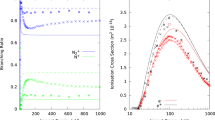Summary
In an attempt to reduce the amount of spurious scattering in the emulsions, two batches of Ilford G-5 and two batches of Ilford K-5 stripped emulsions, 600 Μm thick, have been exposed to the 6.2 GeV internal proton beam from the Berkeley Bevatron, and developed in several different ways. The methods of development used included isothermal development at 5 ‡C, 10 ‡C and 15 ‡C, and temperature cycle development with the warm stages at 10 ‡C, 15 ‡C and 20 ‡C with the plates immersed in a boric acid-potassium bromide solution. For comparison some emulsions were also developed with the ‡ dry ‡, warm development at 25 ‡C which was usually employed in previous work. As a further precaution against distortions in the emulsions potassium alum hardener has been added to the fixing bath, and the emulsions were dried slowly at a temperature below 10 ‡C. Scattering measurements performed on the 6.2 GeV proton tracks in the emulsions have shown that the spurious scattering has been reduced to about half of the value which has usually been obtained previously and by other workers. This applies to all the plates, except for a G-5 emulsion from one batch and developed at 25 ‡C. It has been observed that the amount of spurious scattering depends on the development temperature: (i) It does not change between temperatures of 5 ‡C and 10 ‡C. (ii) Above 10 ‡C there is a gradual increase with temperature, (iii) In some batches of emulsions a marked increase of spurious scattering occurs at a temperature of about 25 ‡C. Some variation in the amount of spurious scattering present in the different batches of emulsions used has been observed, but there appears to be no difference in that respect between the G-5 and the K-5 emulsions. Good grain densities on minimum tracks and improved uniformity of development with depth in both the G-5 and the K-5 emulsions have been obtained using the temperature cycle methods of development with warm stages at 10 ‡C 15 ‡C and 20 ‡C.
Riassunto
Nel tentativo di ridurre l’ammontare di scattering spurio nelle emulsioni, due pacchi di pellioole staccato Ilford G-5 e due di Ilford K-5, dello spessore di 600 Μm sono stati esposti al fascio interno di protoni da 6.2 GeV del Bevatrone di Berkeley, e sono statisviluppati con diversi procedimenti. I metodi seguiti comprendevano lo sviluppo isotermico a 5 ‡C, 10 ‡C e 15 ‡C e lo sviluppo a ciclo di temperatura con gli stadi caldi a 10 ‡C, 15 ‡C e 20 ‡C mentre le lastre erano immerse in una soluzione di acido borico e bromuro di potassio. Per confronte alcune pellicole vennero anche sviluppatecol metodo di sviluppo caldo « a secco » a 25 ‡C clie è stato di solito usato nei lavori precedents. Come ulteriore precauzione contro le deformazioni delle pellicole al bagno di fissaggio fu aggiunto allume potassico come indurente, e le pellicole furono fatte asciugare lentamente a temperatura inferiore a 10‡C. Le misure di scattering eseguite sulle tracce dei protoni di 6.2 GeV nelle emulsioni hanno dimostrato che lo scattering spurio 6 stato ridotto a meta del valore precedentemente ottenuto da noi e da altri autori. Questo vale per tutte le lastre, tranne per una pellicola G-5 di un pacco sviluppata a 25 ‡C. Si è osservato ehe l’ammontare di scattering spurio dipende dalla temperatura di sviluppo corne segue: a) non varia tra le temperature di 5 ‡C e 10 ‡C;b) al disopra dei 10 ‡C si ha un graduale increment o con la temperatura; c) in qualche pacco di emulsioni si osserva un marcato aumento dello scattering spurio a temperature di circa 25 ‡C. Al di sotto della temperatura critica si è riscontrato un piccolo aumento dello scattering spurio con la temperatura. Si sono osservate alcune variazioni nell’ammontare dello scattering spurio prèsente nei differente pacchi di pellicole, ma non sembra ci sia alcuna differenza a questo riguardo fra le emulsioni G-5 e K-5. Buone densità di grana su tracce minime e migliore uniformità di sviluppo nello spessore nelle emulsioni G-5 e K-5 sono state ottenute usando i metodi di sviluppo a ciclo di temperatura con lo stadio caldo a 10 ‡C, 15 ‡C e 20 ‡C.
Similar content being viewed by others
References
S. Biswas, B. Peters andH. Rama:Proc. Ind. Acad. Sci., A41, 154 (1955).
H. Pat:Zeits. f. Naturfor.,10a, 572 (1955).
E. Lohrmann andM. Teucher.Nuovo Cimento,3, 59 (1956).
F. A. Brisbout, C. Dahanayake, A. Engler, P. H. Fowler andP. B. Jones:Nuovo Cimento,3, 1400 (1956).
A. J. Apostolakis, J. O. Clarke andJ. V. Major:Nuovo Cimento,5, 377 (1957).
F. W. Fisher andJ. J. Lord:Nuovo Cimento,11, 44 (1959).
C. C. Dilworth, G. Occhialini andL. Vermaesen:Bull. Centre Phys. Nucleaire Univ. Libre Bruxelles, Note 13a (1950).
B. JudeK:Can. Jonrn. Phys.,37, 102 (1959).
H. G. De Carvalho: private communication, 2eColloque International de Photographie Corpusculaire (Montreal, 1958).
G. Thuro andM. Paic:Nuovo Cimento,4, 887 (1956).
H. Brun, G. Counil andG. Meulemans:Proc. Bagnères Cont. (1953), p. 61.
P. H. Fowler:Phil. Mag.,41, 169 (1950).
K. Gottstein, M. G. K. Menon, J. H. Mulvey, C. O’Ceallaigii andO. Rochat:Phil. Mag.,42, 708 (1951).
Author information
Authors and Affiliations
Rights and permissions
About this article
Cite this article
Judek, B. Reduction of spurious scattering in Ilford G-5 and K-5 emulsions. Nuovo Cim 16, 834–847 (1960). https://doi.org/10.1007/BF02771703
Received:
Published:
Issue Date:
DOI: https://doi.org/10.1007/BF02771703




